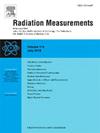Thoron exhalation rate measurement – findings from a large worldwide intercomparison study
IF 2.2
3区 物理与天体物理
Q2 NUCLEAR SCIENCE & TECHNOLOGY
引用次数: 0
Abstract
A global intercomparison study was conducted to measure the thoron (220Rn) exhalation rate from two building materials, with participation from five European laboratories and three Asian laboratories. The test samples—phosphogypsum and unfired clay—were circulated among the laboratories using a sequential proficiency testing scheme. The assigned values and their uncertainties were determined through recommended robustness analysis. For comparison, the classical method, which uses the arithmetic mean of all participants' results, was also applied. Individual measurement results were evaluated for bias, precision, and proficiency in accordance with ISO 13528:2022.
The assigned exhalation rates were (0.39 ± 0.15) Bq m−2 s−1 for phosphogypsum and (0.53 ± 0.15) Bq m−2 s−1 for unfired clay. Z-scores were below 3 for seven of the nine methods used. Bias (Rb) and precision (P) parameters were within 50 %, except in one case. Laboratories provided details on Type A and Type B uncertainties, revealing that detector calibration uncertainty was the dominant factor in most cases.
These findings underscore the need for more robust calibration methods to improve the accuracy of thoron measurements. The development of a harmonised standard would greatly enhance the consistency of thoron exhalation rate measurements. Such a standard should provide guidance on detector calibration, as well as key factors such as climate conditions during sample preparation and testing, procedures for determining exhalation rates and their uncertainties, and considerations for material aging and spatial variations.
呼吸率测量-来自一项大型全球比较研究的结果
在五个欧洲实验室和三个亚洲实验室的参与下,进行了一项全球比较研究,以测量两种建筑材料的钍(220Rn)呼出率。试验样品-磷石膏和未烧制粘土-使用顺序熟练度测试方案在实验室之间循环。通过推荐稳健性分析确定分配值及其不确定性。为了进行比较,我们还采用了对所有参与者的结果取算术平均值的经典方法。根据ISO 13528:2022对单个测量结果进行偏差、精度和熟练度评估。磷石膏的指定呼出速率为(0.39±0.15)Bq m−2 s−1,未烧粘土的指定呼出速率为(0.53±0.15)Bq m−2 s−1。在使用的9种方法中,有7种的z分数低于3。除1例外,偏差(Rb)和精度(P)参数均在50%以内。实验室提供了A型和B型不确定度的详细信息,表明在大多数情况下,探测器校准不确定度是主要因素。这些发现强调需要更强大的校准方法来提高钍测量的准确性。制定统一的标准将大大提高气体呼出率测量的一致性。该标准应提供探测器校准的指导,以及样品制备和测试期间的气候条件等关键因素,确定呼气率及其不确定度的程序,以及对材料老化和空间变化的考虑。
本文章由计算机程序翻译,如有差异,请以英文原文为准。
求助全文
约1分钟内获得全文
求助全文
来源期刊

Radiation Measurements
工程技术-核科学技术
CiteScore
4.10
自引率
20.00%
发文量
116
审稿时长
48 days
期刊介绍:
The journal seeks to publish papers that present advances in the following areas: spontaneous and stimulated luminescence (including scintillating materials, thermoluminescence, and optically stimulated luminescence); electron spin resonance of natural and synthetic materials; the physics, design and performance of radiation measurements (including computational modelling such as electronic transport simulations); the novel basic aspects of radiation measurement in medical physics. Studies of energy-transfer phenomena, track physics and microdosimetry are also of interest to the journal.
Applications relevant to the journal, particularly where they present novel detection techniques, novel analytical approaches or novel materials, include: personal dosimetry (including dosimetric quantities, active/electronic and passive monitoring techniques for photon, neutron and charged-particle exposures); environmental dosimetry (including methodological advances and predictive models related to radon, but generally excluding local survey results of radon where the main aim is to establish the radiation risk to populations); cosmic and high-energy radiation measurements (including dosimetry, space radiation effects, and single event upsets); dosimetry-based archaeological and Quaternary dating; dosimetry-based approaches to thermochronometry; accident and retrospective dosimetry (including activation detectors), and dosimetry and measurements related to medical applications.
 求助内容:
求助内容: 应助结果提醒方式:
应助结果提醒方式:


